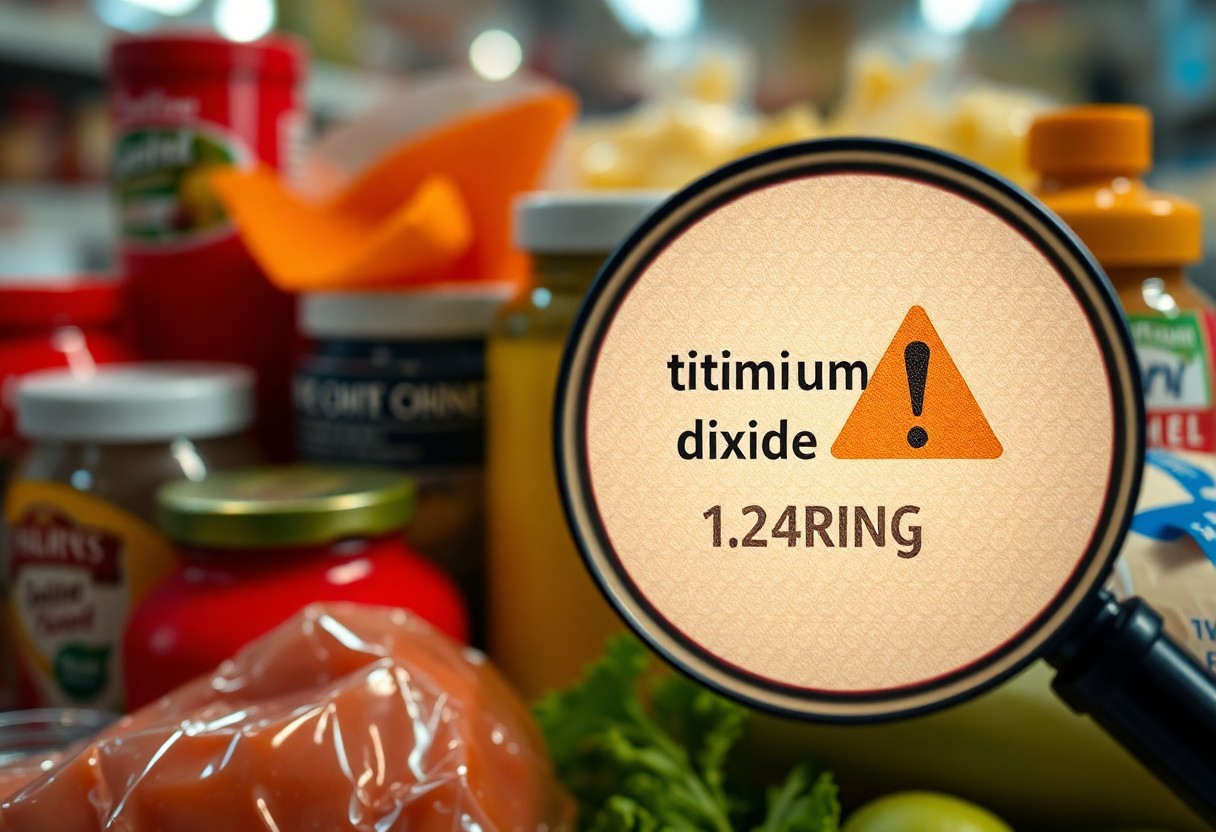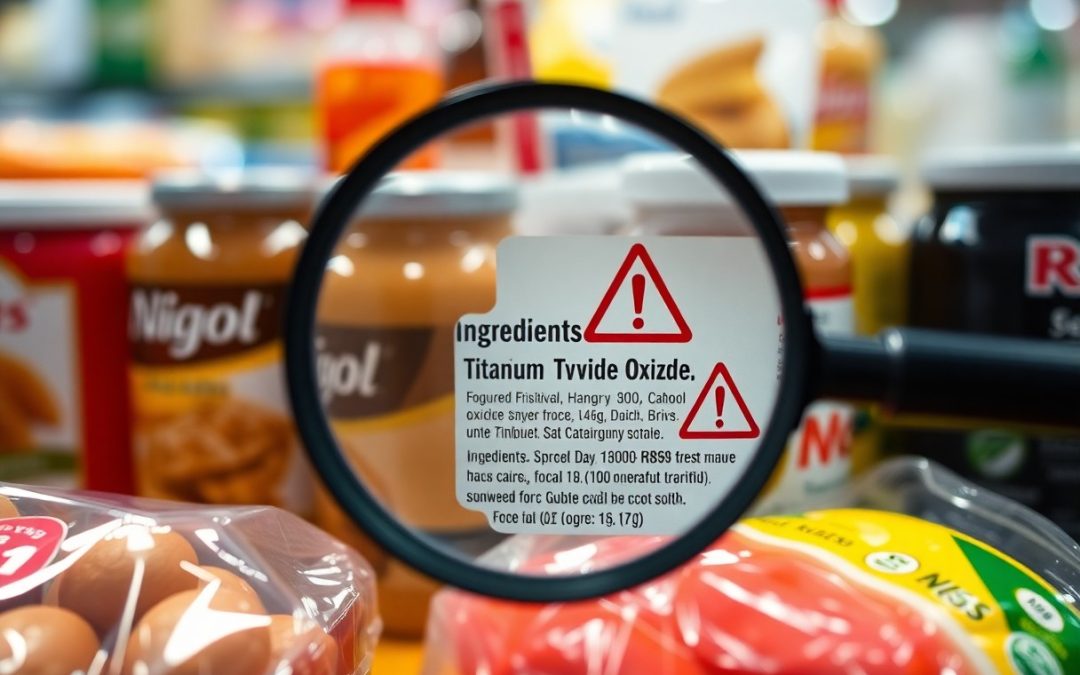There’s a good chance you’ve encountered titanium dioxide in your food without even realizing it. This common food additive, used for its white pigment properties, raises important questions about your safety and health. In this blog post, you will learn about titanium dioxide’s uses, its safety profile, where it’s commonly found, alternative names, and how to limit your exposure. Understanding these aspects can help you make informed decisions about your dietary choices and overall health.
Understanding Titanium Dioxide
The presence of titanium dioxide in your foods and products may not be immediately apparent, but this additive is widely used in various consumer items. It is primarily recognized for its role as a white pigment and is heavily utilized in the food industry, especially in processed foods.
Definition and Natural Sources
On its own, titanium dioxide is a naturally occurring mineral derived from titanium-bearing ores. It appears as a bright white powder and is utilized for its coloring properties in multiple applications, making it a common ingredient in many products.
Common Uses in Consumer Products
Along with its presence in the food industry, titanium dioxide is extensively used in a variety of consumer products, including cosmetics, sunscreen, paints, and plastics. Its ability to provide opacity and whiteness makes it valuable in these applications.
With over 3,000 products containing titanium dioxide available in grocery stores, it’s evident that you might encounter it far more often than you realize. In addition to food items such as candy and baked goods, this additive is prevalent in non-food products like sunscreen and personal care items, where it serves to block UV rays and enhance product appearance. Awareness of its inclusion in your daily products can help you make informed choices about what you consume and apply to your skin.
Safety Concerns and Regulations
It’s important to be aware of the differing safety standards surrounding titanium dioxide. In the United States, the FDA approves it as safe for consumption in small amounts, establishing regulations that set allowable doses significantly lower than potentially harmful levels. However, growing concerns about its safety have sparked debates on whether these regulations are sufficient to protect public health.
FDA Stance and European Ban
At the same time, the European Union has taken a more stringent approach by banning titanium dioxide in food, citing concerns over its potential to cause DNA or chromosomal damage. This ban reflects a precautionary principle, emphasizing that if safety cannot be confirmed, the substance should not be used.
Scientific Research and Health Implications
About ongoing studies have indicated potential health implications related to titanium dioxide consumption, raising red flags regarding long-term effects. As more data emerges, it is vital for you to stay informed about what this may mean for your dietary choices.
For instance, research has pointed to possible toxicity in high doses, prompting calls for further investigation into its effects on human health, especially considering that it is found across over 3,000 food products. Such findings may impact your dietary decisions, leading you to reconsider foods that contain this additive and prompting you to explore safer alternatives for your health.

Common Sources in Food
If you’re reading food labels, you may be surprised to find titanium dioxide in many processed products. This additive is commonly found in items such as candies, baked goods, and dairy products like shredded cheese, where it enhances appearance and texture. While the FDA considers small amounts safe, its widespread use can lead to increased exposure in your everyday diet.
Types of Products Containing Titanium Dioxide
Dioxide is prevalent in various packaged items, contributing to their visual appeal and consistency. Common products include:
- Confectionery
- Baked goods
- Shredded cheese
- Creamers
- Trail mix
Thou may want to check ingredient labels to minimize your intake.
Industry Applications
Beside food, titanium dioxide is also widely used in several industries, including cosmetics, paints, and plastics. Its properties make it a go-to pigment for providing brightness and opacity in these products. This versatility contributes to its prevalence across multiple sectors.
Further, titanium dioxide’s applications extend beyond food and cosmetics. In the paint industry, it is employed to enhance color and durability, while in the plastics sector, it acts as a brightening agent. Additionally, it’s utilized in sunscreens for its ability to block UV rays, showcasing its role in both aesthetics and safety across various products. Understanding its presence in everyday items can be important for your overall well-being.

Identification on Labels
Despite titanium dioxide’s widespread use in food products, identifying it on ingredient labels can be challenging. In the United States, it is typically listed as “titanium dioxide” or “E171,” but not all products may highlight its presence. To make informed choices about your diet and potential exposure, it’s necessary to familiarize yourself with how titanium dioxide may be labeled in the items you frequently purchase.
Common Names and Terminology
For many consumers, understanding the common names associated with titanium dioxide can help in identifying its presence in food products. You may come across terms like “titanium white” or “CI 77891” as designations in food and cosmetic labels. These terms indicate that titanium dioxide is being used, typically for its coloring and opacity properties.
Reading Product Labels
Product labels can provide vital information regarding the ingredients in your food. Knowing what to look for helps you make educated decisions. Familiarize yourself with common additives and their alternate names, such as titanium dioxide, to better navigate food choices.
It is important to scrutinize product labels for titanium dioxide and other ingredients. Given it appears in over 3,000 products, including processed foods, you might find it listed near the end of the ingredient list, indicating it’s used in smaller quantities. Pay attention to these labels, especially when selecting snacks, candies, and baked goods, which often contain additives that may affect your overall health. By being aware of these ingredients, you can successfully limit your exposure and choose healthier options for you and your family.
Health Effects
After recent studies raised concerns about the safety of titanium dioxide, many consumers are questioning its potential health impacts. While the FDA considers it safe in small amounts, the European Food Safety Authority has linked titanium dioxide to possible DNA and chromosomal damage, prompting a ban in the EU. Understanding these implications is important as you make informed choices about the foods you consume.
Potential Risks
Between research findings and regulatory assessments, potential risks associated with titanium dioxide emerge. Some studies suggest that ingesting high doses could lead to adverse effects, including possible toxicity and DNA damage. Although titanium dioxide is permitted in U.S. foods, awareness of its presence in your diet can help you make safer food choices.
Safe Consumption Levels
By regulatory standards, the FDA sets consumption limits for additives like titanium dioxide to minimize risk. They determine harmful doses and establish permissible levels that are typically 100 times lower than the threshold for adverse effects. Being aware of these guidelines helps you monitor your intake and assess your dietary risks regarding titanium dioxide.
Hence, understanding the safe consumption levels for titanium dioxide can empower you to manage your dietary choices effectively. The FDA’s approach is designed to protect you by ensuring that any food additive’s presence remains well within safety margins, reflecting a commitment to your health. However, you should still consider the cumulative effects of various food additives in your diet, seeking out whole foods whenever possible to reduce reliance on processed options that may contain additives such as titanium dioxide.
Avoiding Titanium Dioxide
For those concerned about titanium dioxide in food, you can reduce your exposure by opting for fresh or minimally processed foods. Focus on whole fruits, vegetables, and grains, which generally do not contain additives. Additionally, reading ingredient labels will help you identify and avoid products that list titanium dioxide, allowing you to make more informed choices for your diet.
Alternative Products
To avoid titanium dioxide, consider using natural alternatives in your meals. Look for brands that emphasize clean ingredients and avoid artificial additives, opting for organic and non-GMO options wherever possible. Many manufacturers now offer substitutes that provide similar benefits without the potential risks associated with titanium dioxide.
Shopping Guidelines
Products that contain titanium dioxide are commonly found in packaged and processed foods. To steer clear of them, prioritize fresh ingredients and choose items labeled as free from artificial colors and additives.
Another effective shopping strategy involves familiarizing yourself with common food categories that often contain titanium dioxide, such as candy, baked goods, and certain dairy products. Check for alternative brands or those that specifically advertise their commitment to natural ingredients. By being proactive about reading labels and making mindful choices, you can better protect your overall health and reduce your exposure to titanium dioxide in your diet.
Conclusion
To wrap up, understanding titanium dioxide in food is crucial for making informed dietary choices. While it serves various functions as a food additive, current debates about its safety suggest you should be cautious about your exposure. You can find titanium dioxide in many packaged foods, so reviewing labels and opting for less processed options will help you limit your intake. Staying informed about other names for this additive can further empower you to protect your health. Always prioritize nourishing your body with whole, unprocessed foods for better overall wellness.


